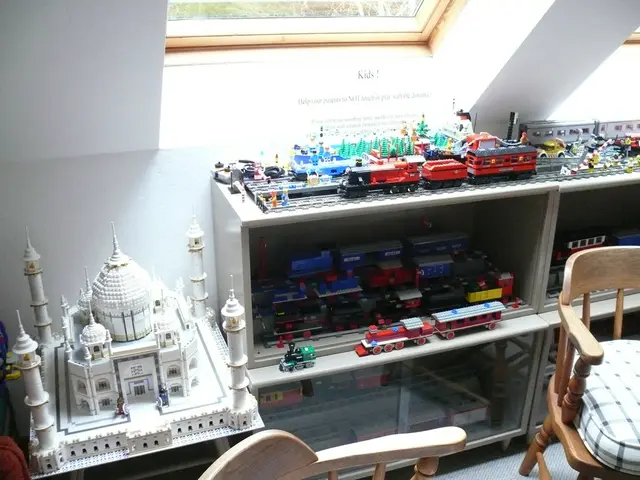Guide for Crafting a Safe and Inclusive Home Setup
In Australia, there are several financial assistance programs and grants available to help individuals improve the accessibility of their homes.
The Assistive Technology and Home Modifications (AT-HM) scheme is a key program that provides funding for home modifications and assistive technology based on assessed needs. This includes grab rails, handrails, non-slip surfaces, bathroom redesigns, ramps, and stair lifts, with funding tiers varying from under $500 for low-cost modifications up to $15,000 for high-cost home modifications.
Another initiative is the Commonwealth Accessible Australia initiative, which provides funding to improve accessibility for people with disabilities. This initiative, however, mainly focuses on public facilities rather than individual home modifications.
While other grants such as mental health and housing justice grants exist, they do not specifically address home accessibility modifications for individuals in their homes. Financial crisis support programs focus on broader financial wellbeing and may not cover home modifications.
Walk-in showers, where the shower floor is flush with the bathroom floor, can be particularly beneficial for people with reduced mobility as they can simply walk into the shower without having to step up and down. Rail showers, which allow the removable hand-held showerhead to be fixed to an adjustable bracket, providing flexibility in height and angle, are also a practical solution.
Ramps are an effective way to improve a building's accessibility for homes that have a raised entrance, making it easier for people with reduced mobility or using mobility aids to enter the home. Grab rails improve accessibility and safety around baths, showers, and toilets by providing a secure, easy-to-hold support to reduce the risk of slips and falls.
LED light bulbs are the most cost-effective and longest-lasting lights, reducing the need for ladder use for replacement. Smart locks, including smartphone, biometric, and touchscreen locks, can make it easier for those with limited mobility. Choosing tapware with mixer-style handles that can be moved instead of screwed is a more accessible option for people with reduced mobility.
For those living in Victoria, renovating an existing property may require the building to be brought into line with the Livable Housing Design Standards, depending on the extent of the proposed alterations. These standards aim to improve the accessibility of housing for those with reduced mobility and include at least one step-free entry, at least one step-free entry to a bathroom and shower, an accessible toilet, reinforced bathroom and toilet walls for handrails, wider internal doors and corridors.
To ensure the safety of hot water systems, it's crucial to contact a licensed plumber to have your system checked for a tempering valve. Older homes (before 1998) may not have tempering valves installed, posing a scald risk, especially for those with reduced mobility or increased accessibility needs.
Reverse-cycle split systems are safer, more energy-efficient alternatives to single-room gas heaters for heating and cooling homes. Non-slip mats can improve safety in various areas of the home, including bathrooms, kitchens, and laundries, and non-slip tape or stair nosing can be applied to stairs.
For detailed eligibility and application processes, it is advisable to refer to government portals or contact local disability support services. For more information about the NDIS and its support for home modifications, visit the NDIS website. It is important to remember that any modification that includes plumbing or electrical work should only be done by a licensed professional.
[1] AT-HM Scheme Information [2] Mental Health and Housing Justice Grants [3] Commonwealth Accessible Australia Initiative [4] Financial Crisis Support Programs [5] Housing Assistance Program
- The AT-HM scheme, a crucial Australian program, provides funding for home modifications and assistive technology based on assessed needs.
- This includes items like grab rails, handrails, non-slip surfaces, bathroom redesigns, ramps, and stair lifts.
- Funding tiers vary, with low-cost modifications receiving under $500 and high-cost home modifications up to $15,000.
- Another initiative is the Commonwealth Accessible Australia, providing funding to improve public facilities' accessibility for people with disabilities.
- Mental health and housing justice grants exist, but they do not specifically address home accessibility modifications.
- Financial crisis support programs focus on broader financial wellbeing and may not cover home modifications.
- Walk-in showers, where the shower floor is flush with the bathroom floor, can be beneficial for people with reduced mobility.
- Rail showers, with adjustable brackets for removable hand-held showerheads, offer flexibility in height and angle.
- Ramps improve accessibility for homes with raised entrances, aiding people with reduced mobility or using mobility aids.
- Grab rails around baths, showers, and toilets provide a secure support, reducing the risk of slips and falls.
- LED light bulbs are cost-effective and longest-lasting, reducing the need for ladder use for replacement.
- Smart locks, such as those that use smartphones, biometrics, or touchscreens, can make home access easier for those with limited mobility.
- Mixer-style tap handles, which can be moved instead of screwed, are a more accessible option for people with reduced mobility.
- In Victoria, renovating a property may require adherence to the Livable Housing Design Standards for improved accessibility.
- These standards include at least one step-free entry, accessible toilets, reinforced bathroom and toilet walls for handrails, and wider internal doors and corridors.
- For hot water system safety, contact a licensed plumber to check for a tempering valve, especially in older homes before 1998.
- Reverse-cycle split systems are safer and more energy-efficient alternatives to single-room gas heaters for heating and cooling homes.
- Non-slip mats improve safety in various areas of the home, while non-slip tape or stair nosing can be applied to stairs for added safety.
- For detailed eligibility and application processes, refer to government portals or contact local disability support services.
- The NDIS website provides information about the NDIS and its support for home modifications.
- Any modification involving plumbing or electrical work should only be done by a licensed professional for safety reasons.
- Skin care, a part of health and wellness, involves the practice of maintaining the health of the skin to prevent medical conditions and maintain a youthful appearance.
- The manufacturing industry, a significant part of the overall economy, produces a wide range of goods, including cars, furniture, textiles, and electronics.
- The retail industry involves the sale of products from vendors to consumers, often through brick-and-mortar stores, online stores, or both.
- Climate change, a major environmental concern, refers to long-term changes in temperature and typical weather patterns.
- Fitness and exercise are essential aspects of health and wellness, promoting physical health, mental wellbeing, and preventing medical conditions.
- The finance industry deals with money, credit, and investments, providing services like banking, investments, wealth management, and personal finance.
- Energy, a critical aspect of our lives, is used in various sectors, including manufacturing, transportation, and homes, and must be managed sustainably for the sake of the environment.




